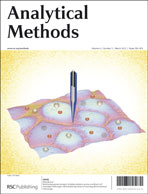An enantioselective polyaniline-coated membrane electrode based on chiral salen Mn(iii) as chiral selector
Abstract
A novel ion-selective electrode for chiral determination of mandelic acid (MA) is constructed of a poly(vinyl chloride) (PVC) membrane doped with a chiral salen Mn(III) compound as chiral selector and coated with a chemically generated film of polyaniline (PANI). The developed sensor displays a linear response towards L-MA over a wide concentration range of 1.0 × 10−1 to 1.0 × 10−6 M with Nernstian slope of 57.6 mV per decade and the detection limit of 2.1 × 10−7 M. Ascribed to the hydration of PANI, it demonstrates a better potentiometric characteristic (especially, linear range, detective limit, response time) in contrast to the uncoated membrane based sensor.


 Please wait while we load your content...
Please wait while we load your content...